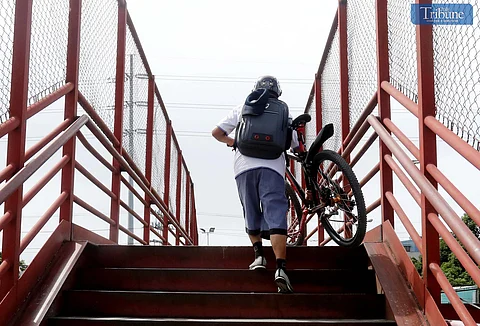
- NEWS
- the EDIT
- COMMENTARY
- BUSINESS
- LIFE
- SHOW
- ACTION
- GLOBAL GOALS
- SNAPS
- DYARYO TIRADA
- MORE

Filipinos want to walk. They want to commute safely, cross the street without risking their lives, and move around their cities with ease. But the roads, the sidewalks — or the lack of them — tell a different story. For many, especially persons with disabilities (PWDs), the elderly, and even the everyday worker, walking in the Philippines is a gamble with death.
That was the central message of the #FIXPH Roundtable organized by the Move As One (MAO) Coalition, where urban planners, transport officials, and pedestrian advocates came together for a frank conversation on the country’s broken pedestrian infrastructure.
Filipinos spend 77.5% of their travel time walking, and yet only 5% of roads are considered safe for pedestrians. A staggering 94% of Filipinos walk or take public transportation, while only 6% own cars. Despite this, roads are built for vehicles — not people.
“At some point in our daily journeys on the road, we all need to walk. But we live in an unwalkable country, where there is a lack of safe infrastructure that supports and encourages walking,” said Robert Siy, co-convenor of the Move As One Coalition. “Poor walkability in our cities makes all of us poor.”
In a powerful video shown during the event, ordinary Filipinos were seen navigating broken sidewalks, crossing highways with no pedestrian lanes, ducking under barriers, and walking beside moving vehicles — all to simply get to work, home, or school.
One participant summed it up best: “Walking is a deathtrap in the Philippines.”
This well-known sign — “No crossing, deadly” — can be seen across the country. It was also the title of Dinna Dayao’s presentation. As the communication consultant of MAO, she delivered blunt truths: pedestrian deaths account for 22.59% of all road fatalities, and the infrastructure designed to “protect” them — like footbridges — are often inaccessible, inconvenient, and dangerous.
“Footbridges are examples of hostile infrastructure. They are a waste of money,” Dayao said. She recalled injuries sustained by people who had to jump over barriers or climb steep stairs due to poor design. “Lack of well-designed infrastructure equals limb fractures.”
Dayao added, “We don’t have support for Filipinos who want to walk.”
For Maureen Ava Mata, accessibility advocate and member of the PWD community, commuting feels like a daily physical and emotional battle.
“How am I going to reach the bus station in the first place?” she asked during her talk on Inclusive Mobility. “It’s like I’m climbing a mountain.”
“Disability is part of human diversity,” Mata said. “We want to be included in your plans, and we want you to implement them.”
Fifteen percent of the Philippine population are PWDs, yet streets remain largely hostile to them. “When pedestrian infrastructure is hostile to regular Filipinos, imagine what it's like for us.” Mata emphasized the desire of PWDs and senior citizens to be independent — to move freely without needing someone else’s assistance.
Architect Jose Ramon Carunungan, Principal Architect of C&P Co., echoed this: “If the streets are comfortable for PWDs, then they are comfortable for everyone. We should have even more capability.”
Even government agencies acknowledge the dire situation. Tony Pagulayan, MMDA Head of Traffic Education, pointed out how some barangay ordinances allow car owners to park on sidewalks, further squeezing pedestrians off their already narrow path.
He also noted the alarmingly high number of fatal pedestrian crashes in Metro Manila — a fact supported by the data presented during the roundtable.
“There are so many factors involved in planning an urban city and one of the most important is transport,” said Architect Carunungan. “The process of designing has to do with culture. We cannot just copy what others have done because we have a unique culture here.”
Carunungan added that effective urban solutions don't always require massive budgets. “We don’t need to spend much on infrastructure. Sometimes, good policies that prioritize pedestrians are all we need.”
Car-free Sundays, pedestrian-only hours, and inclusive urban planning were some of the low-cost, high-impact policies mentioned. These have been tried in places like Makati and BGC, where residents enjoy more walkable environments.
"If transportation is good, you have time to sleep, time to eat, and time to go wherever you want after work,” Carunungan emphasized.
Former PCUP Chairman Hernani Panganiban emphasized the importance of public participation in urban planning. “People's consultation is important. They have to be part of the planning process.”
And the people are speaking: 85% of Filipinos want their cities and towns to be walkable. Many communities already embrace walkability through initiatives like car-free Sundays, but national and local governments must catch up. In a country where walking is necessary for the vast majority, urban design cannot remain an afterthought.
